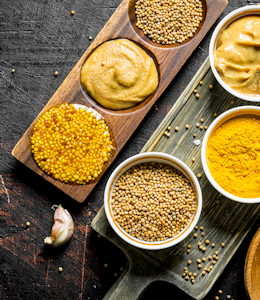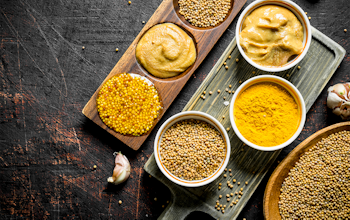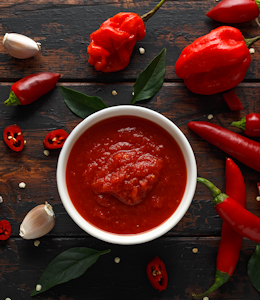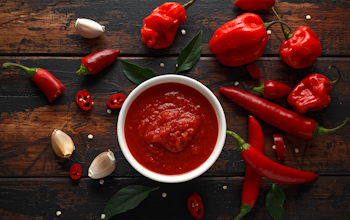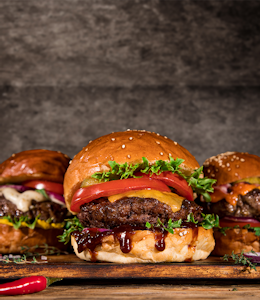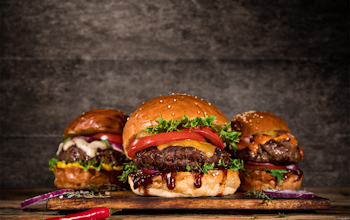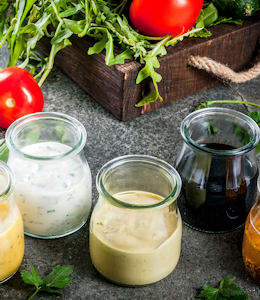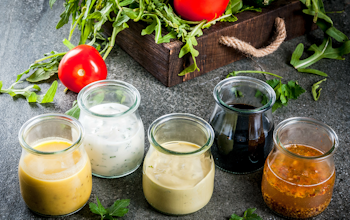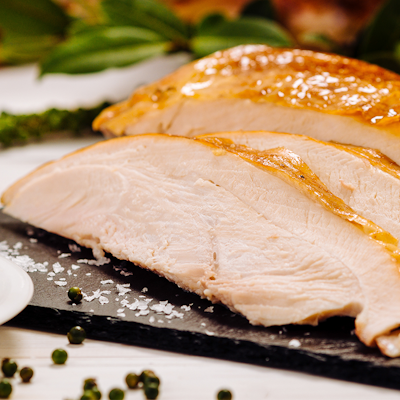Best Condiments
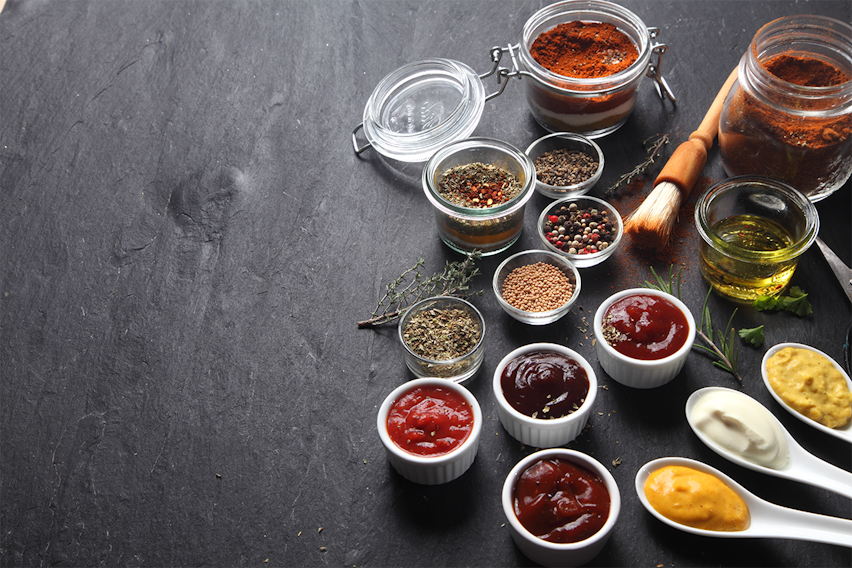
The top 10 most popular condiments have something in common - they can change an average meal into a great one.
That’s why we’ve put together this definitive list of the best condiments to keep in the kitchen.
They are:
- Yellow mustard
- Relish
- Vinegar
- Wasabi
- Hot sauce
- Dijon mustard
- Mayonnaise
- Ketchup
- Barbecue sauce
- Soy sauce
Now let's find out what they're made of, the best ways to use them, and whether they contain any allergens...
Yellow Mustard

What is yellow mustard?
Yellow mustard is a tangy yellow condiment made from water, turmeric (which gives it its distinctive colour), vinegar and most importantly, ground yellow or white (sinapis alba) mustard seeds. The spicy flavour of mustard comes from the oil formed by enzymes when the seed is crushed and broken.
Commercial yellow mustard also contains spices and flavour enhancers such as paprika and garlic flavouring.
The condiment of mustard dates back to Roman times but yellow mustard specifically (and its association as a hot dog topping) gained popularity in St. Louis, USA, at the 1904 World’s Fair when the R.T French Company introduced their iconic yellow bottle of the stuff.
What is yellow mustard used for?
Yellow is primarily associated with hot dogs - used alongside fried onions and ketchup as the definitive topping. It’s a staple of American cooking and is also used in the following:
- Burger toppings
- Soft pretzel toppings
- Potato salads
- Salad dressings ingredients
- Marinade ingredients
Is yellow mustard vegan?
Yes, yellow mustard is vegan and does not contain animal products.
Allergen alert
Mustard is one of the 14 major food allergens.
What is a condiment?
A condiment is a food added to other food or dishes to add or enhance flavour, either as an accompaniment or an ingredient. Condiments are usually liquid or paste, and the name condiment comes from the Latin word for pickled or preserved foods.
Relish
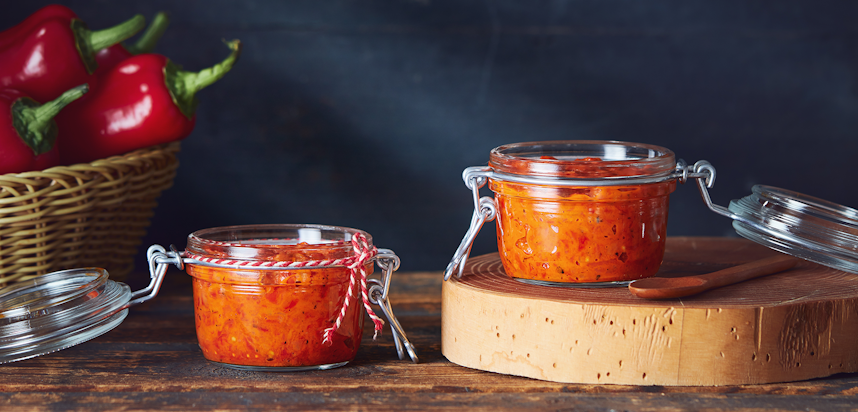
What is relish?
Relish is a condiment made of chopped up vegetables, pickles, herbs (and sometimes fruits) that have been cooked and pickled.
The most famous English example of relish is probably Piccalilli, which is made from cauliflower, pearl onions, cucumbers and other vegetables alongside spices, capers, vinegar and sugar.
The type of relish that is hugely popular in America is made primarily from cucumbers, but onion, garlic, chillies, pickles and mustard are also sometimes among the ingredients.
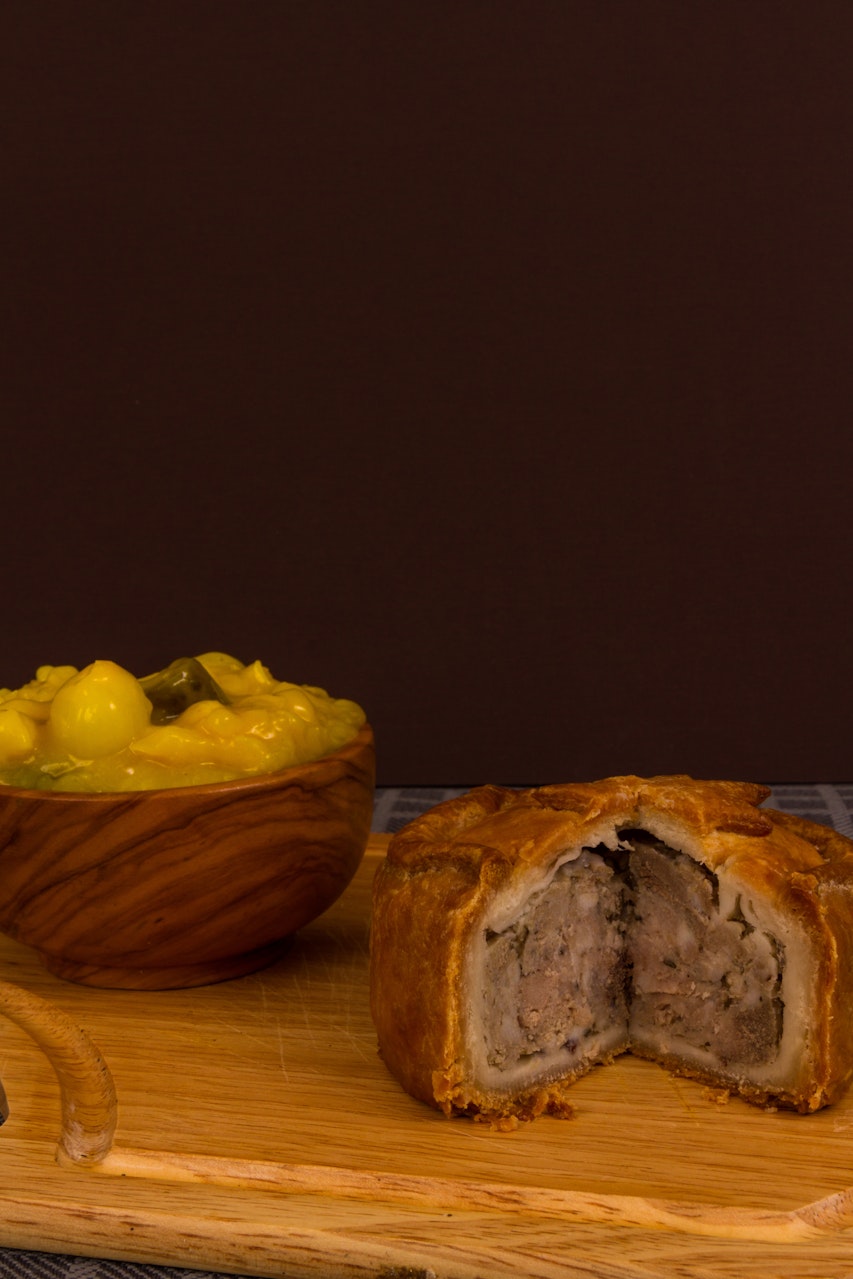
What is relish used for?
Relish is often served on the side of light meal, and also as the following:
- Sandwich filling
- Dip for nachos
- Accompaniment for meat pies and other pastries
- In a salad
- Burger topping
Is relish vegan?
Yes, the vast majority of relish is vegan and vegetarian.
Allergen alert
Relish contains vinegar, some varieties of which contain Sulphur Dioxide and Cereals containing Gluten. Depending on the type of relish, Celery and Mustard may also be among the ingredients.
Vinegar
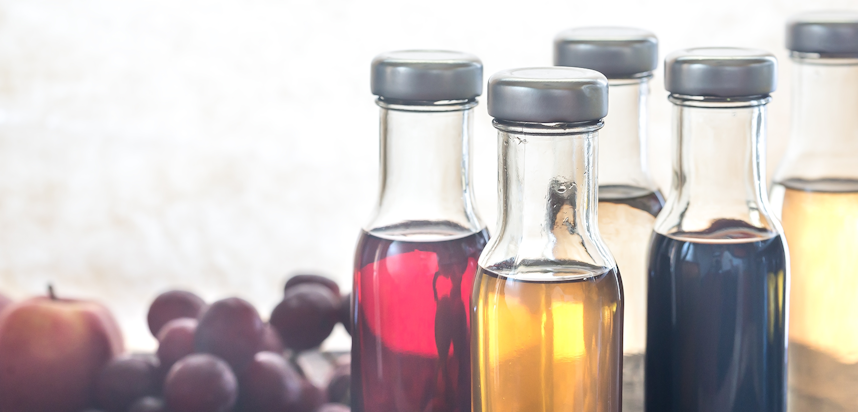
What is vinegar?
Vinegar is a liquid condiment made from acetic acid (in various forms) and water. It also may contain flavourings. It has a very sharp, clean taste, owing to the acetic acid, which accounts for about 5-8% of the solution’s volume - although some white vinegar made specifically for cleaning purposes has an acetic volume closer to 20%.
There are many varieties of vinegar, including:
- Malt vinegar - made from malted grains of barley
- White wine and red wine vinegar - made from white or red wine, where the wine is converted to acetic acid
- Cider vinegar - made from fermented apple juice
- Sherry vinegar - made from fermented sherry
- Balsamic vinegar - made from the aged must of white grape juice
What is vinegar used for?
In the UK, white or malt vinegar is most commonly used alongside salt to add flavour to chips. Various types of vinegar are also used as ingredients in the following:
- Marinades
- Chutneys
- Preservatives
- Salad dressings
- Tomato sauces
- Refried beans
- Pickled foods
- Smoothies
- Other condiments such as mustard, ketchup, relish and barbecue sauce
Balsamic vinegar is also used alongside olive oil to dip bread into.
Is vinegar vegan?
Most vinegar is vegan as the raw ingredients are not animal derived, but some wine and sherry vinegars can be unsuitable for vegans, as animal products may have been used in the production process.
Allergen alert
Many varieties of vinegar contain Sulphur Dioxide, one of the 14 major food allergens. Some varieties of vinegar - such as malt vinegar, are derived from plants like barley and will therefore contain Cereals containing Gluten, another of the 14 major food allergens.
Is jam a condiment?
Jam can technically be classed as a condiment, but it is more commonly seen as a preserve.
Wasabi
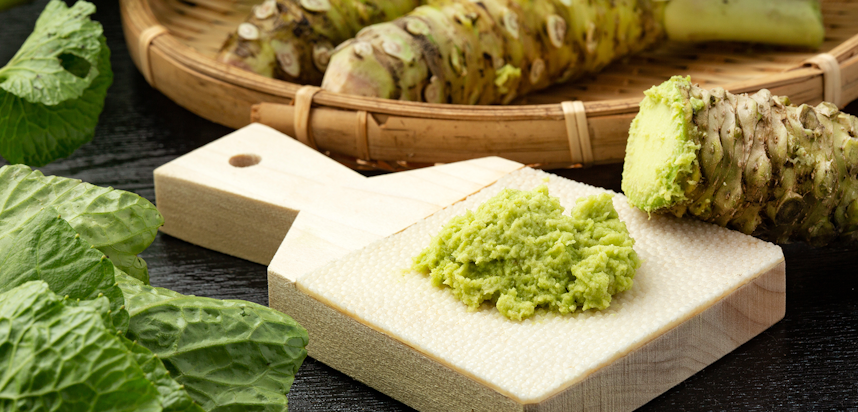
What is wasabi?
Wasabi is a condiment paste made from the ground rhizomes of the wasabi plant (also known as Japanese horseradish). It has an incredibly hot and spicy taste, which comes from the chemical allyl isothiocyanate, which is also present in horseradish.
The vast majority of wasabi served in the West does not actually contain genuine wasabi, and is instead a paste made from a combination of ingredients such as horseradish or horseradish powder, mustard flour or extract, sunflower oil, cornstarch, salt, water, colourings, flavourings and a small amount of genuine Japanese wasabi.
What is wasabi used for?
Wasabi is served as a condiment at most Japanese restaurants, usually in very small amounts as it is very strong. It is eaten in the following ways:
- To accompany sushi
- To accompany sashimi
- Coated on dried peas to make the snack wasabi peas
- A wasabi ice cream
- As an ingredient in a marinade
- Mixed with butter
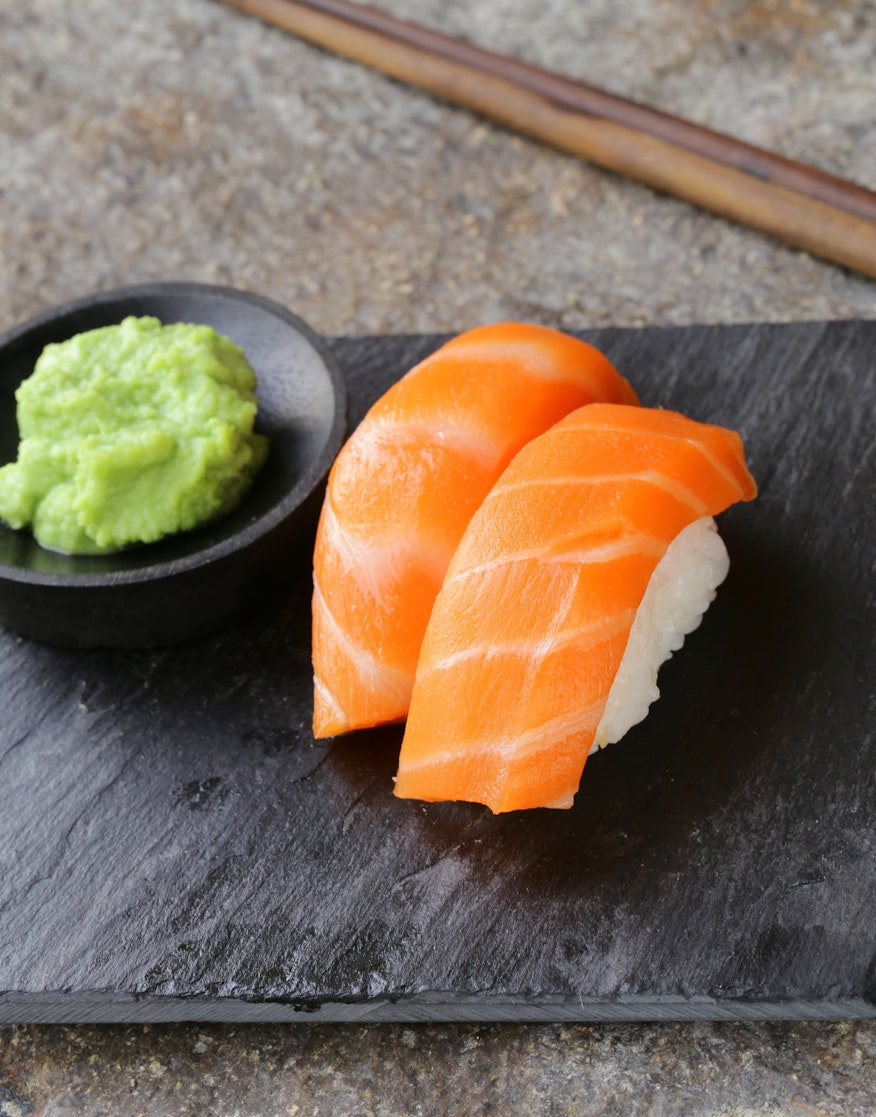
Is wasabi vegan?
Yes, wasabi is made from a plant. Western “wasabi” is also vegan.
Allergen alert
Most Western “wasabi” contains Mustard, to help give it a spicy flavour.
Horseradish
Horseradish and wasabi have a similar flavour profile and come from the same plant family, Brassicaceae. Horseradish is often used as a substitute for wasabi, although in actual fact it is hotter and less sweet than real wasabi, which has a fresh taste. The condiment we know as horseradish is made by combining prepared horseradish (a mixture of grated horseradish root, salt and vinegar) with cream or mayonnaise.
Hot Sauce
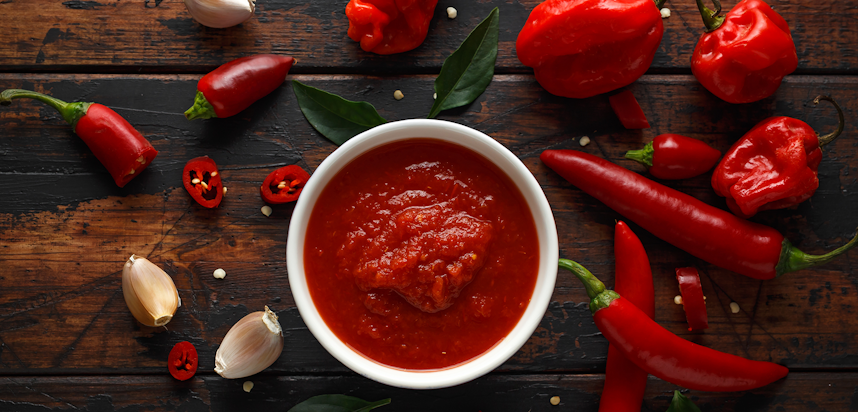
What is hot sauce?
Hot sauce is a spicy condiment. The name is an umbrella term for any condiment or sauce made with a base of chilli peppers.
Early forms of hot sauce date back thousands of years, particularly in places in South America and Central America.
There are hundreds of hot sauces on the market, with chilli peppers such as the Ghost pepper or Habanero pepper used to make incredibly hot and spicy versions. The chillies or chilli paste might be combined with any number of ingredients such as sugar, salt, garlic, sunflower oil, rapeseed oil, vinegar, xanthan gum, paprika, cayenne pepper and flavourings.
Some popular varieties of hot sauce include Tabasco, Sriracha and Scotch Bonnet hot sauce.
What is hot sauce used for?
There are some people who will put hot sauce on just about everything they eat, but more commonly it is used to add kick or bite to foods such as:
- Noodles
- Egg dishes
- Chips or fries
- Popcorn
- Nuts
- Coating on crackers and corn
- Chicken wings
- Chicken and ribs
- Soups
Is hot sauce vegan?
Hot sauce is usually vegan, but occasionally non-vegan ingredients such as cream or honey might be found among the ingredients.
Allergen alert
Depending on the variety, hot sauce might contain any number of allergens so it’s best to check labels carefully.
Because vinegar is a main ingredient, Sulphur Dioxide and Cereals containing Gluten may be present, as well as additional ingredients such as Mustard (in the form of oil or powder), Celery (powder or pickled), (Tree) Nuts, Peanuts, Sesame and Soya (through flavourings).
Dijon Mustard
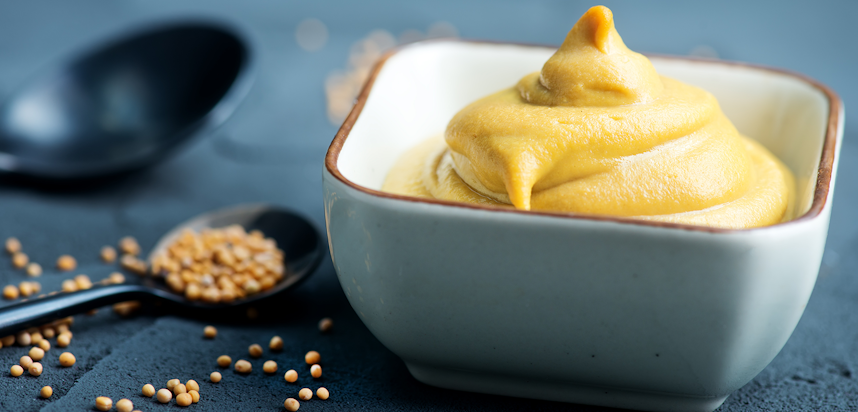
What is dijon mustard?
Dijon mustard is a variety of the condiment mustard made from ground brown mustard seeds, white wine and verjuice, an acidic liquid made from pressed unripe grapes or crab apples and which gives dijon it’s unique, slightly spicy flavour. Predictably, dijon mustard originates from the French town of Dijon, in the Burgundy region. This town was the centre of the mustard industry in the middle ages and in the 17th century it was given the exclusive rights to production. Grey-Poupon, probably the most famous dijon mustard manufacturer, was established in in 1877 by Maurice Grey and Auguste Poupon.
Modern dijon mustard isn’t necessarily made with verjuice, but a combination of water, mustard seeds, white wine, salt and flavourings..
What is dijon mustard used for?
Dijon is frequently eaten with meat, and in the following ways:
- In salad dressings
- In French cooking
- Mixed with mayonnaise to make dijonnaise
- Added to scrambled egg whites
- In sandwiches
- In Mashed potatoes
- On grilled cheese
Is dijon mustard vegan?
Authentic dijon mustard is not vegan, because of the ingredient verjuice. The filtering of verjuice usually involves animal by-products.

Allergen alert
Mustard is one of the 14 major food allergens, and dijon mustard may also contain Sulphur Dioxide from white wine or vinegar.
Is honey a condiment?
Technically, honey is a condiment, though it adds sweetness to foods rather than flavour. However, honey is much more versatile than most condiments.
Mayonnaise
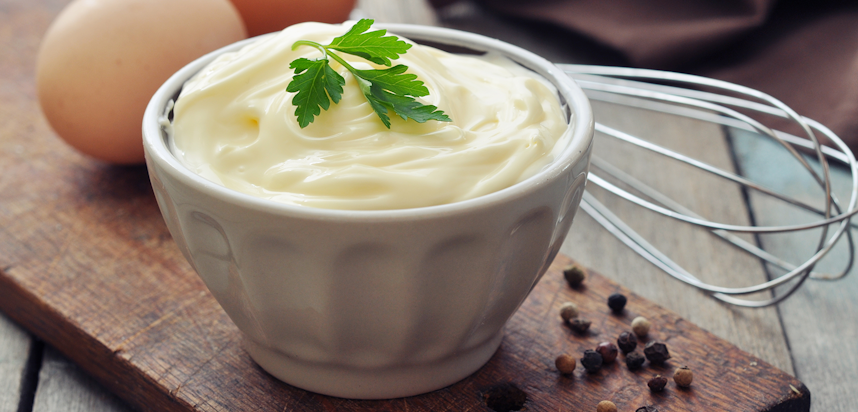
What is mayonnaise?
Mayonnaise is creamy sauce or condiment, served cold and made by emulsifying eggs with oil and vinegar (or lemon juice). It was first recorded in 1806 as part of French cuisine, and can be made by whisking the ingredients together with a fork - though a blender, mixer or even hand whisk are more commonly used.
Vigorous whisking is very important to the process of making mayonnaise, as it disperses the oil and gives the desired thick, silky texture.
What is mayonnaise used for?
Mayonnaise is a very popular condiment and used in a huge variety of foods, such as:
- In sandwiches and wraps
- A dip for chips
- Mixed with tuna to make tuna mayo or a tuna melt
- On a burger, particularly chicken burgers
- In salad dressing
- In coleslaw
- As a dip for seafood
- In coronation chicken
- sandwiches, hamburgers, composed salads, and French fries.
- As the base for various other sauces, such as tartar sauce
Is mayonnaise vegan?
No, mayonnaise is made from Eggs. However it is vegetarian.
Allergen alert
Eggs are a primary ingredient in mayonnaise, and one of the 14 major food allergens. Vinegar, also a main ingredient, sometimes contains Sulphur Dioxide.
Salad Cream
Salad cream and mayonnaise have a similar creamy flavour and texture, due to the similar ingredients. However, the ingredients are used in different quantities - mayonnaise uses more oil than vinegar and salad cream more vinegar than oil - and as a result, mayonnaise contains three times the amount of oil salad cream does. This means salad cream is lower in calories and in fat.
Mayonnaise is richer and more concentrated, so it is better for salad dressings, and salad cream is better to use as a condiment on salad.
Ketchup
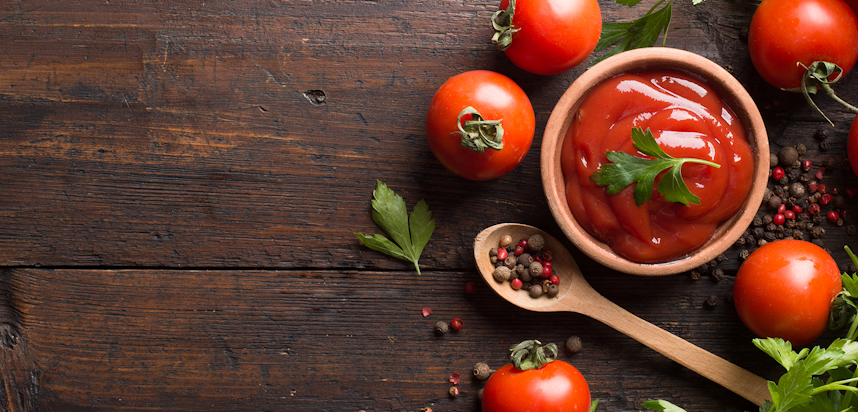
What is ketchup?
Ketchup is a tomato-based condiment, known in some places as catsup. It is believed to have Chinese origins, due to the similarity in name to a Southeast Chinese fermented fish sauce that British travellers in the 17th and 18th centuries are thought to have brought back to England and attempted to replicate. This sauce, and early American varieties of ketchup, did not contain tomatoes, instead using ingredients such as egg whites, oysters, grapes, nuts, anchovies and most prominently, mushrooms. An 1812 recipe for ketchup by horticulturist James Mease as containing tomatoes, spices and brandy.
The most famous variety of ketchup - produced by Heinz, was introduced in 1876. Its recipe included vinegar - to avoid spoilage, and a secret mixture of spices. Modern ketchups still have a tomato base and include vinegar and sugar amongst the ingredients. Depending on the variety, salt, herbs, celery, apples and any number of spices or flavourings may also be found in the sauce.
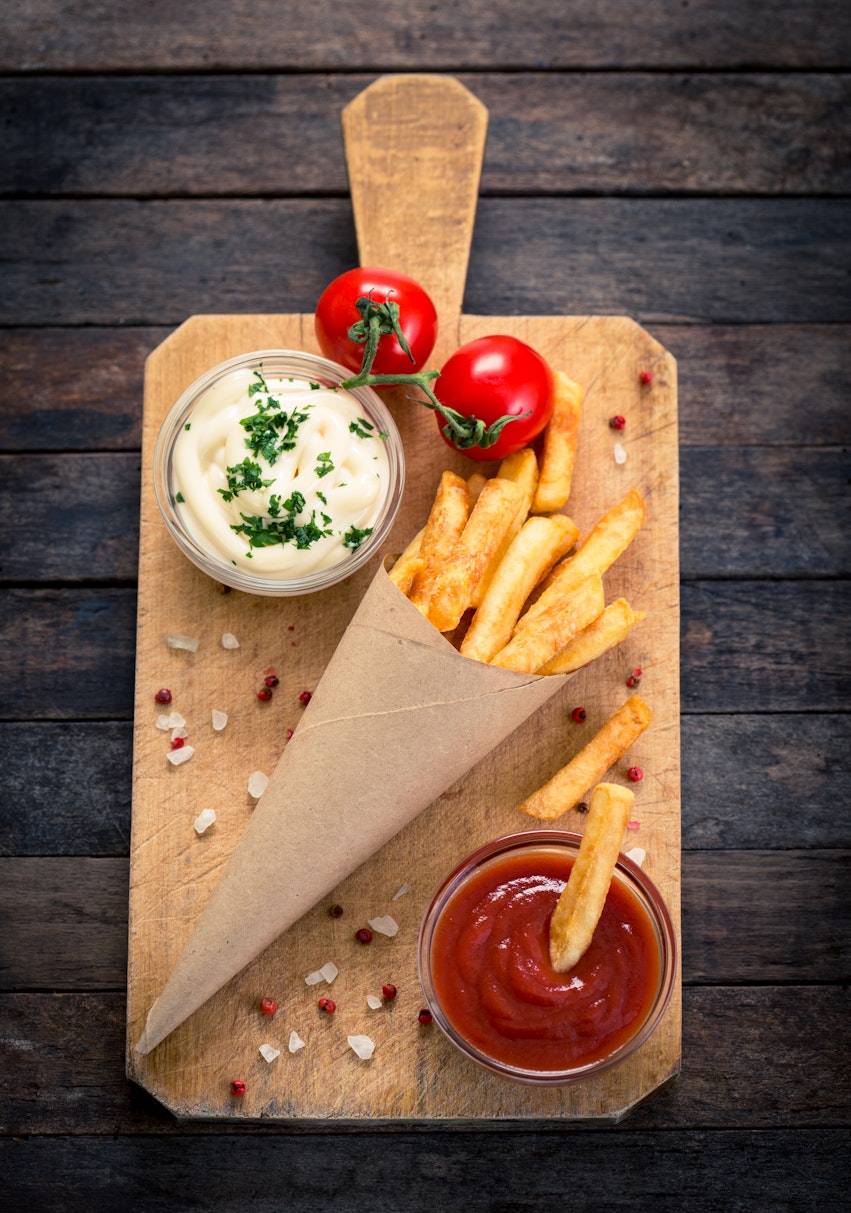
What is ketchup used for?
Ketchup is frequently eaten with fast food products, and also in the following ways:
- On burgers
- On hot dogs
- With chips
- In some American chilli recipes
- As an ingredient in a meat glaze
- As an ingredient in barbecue dishes
- As the base for barbecue sauce
- In meatloaf
- In a sloppy Joe
- As part of the prawn cocktail sauce
- As an ingredient in coleslaw
Is ketchup vegan?
Largely speaking, yes, ketchup is vegan. Very strict vegans might not eat some brands of sugar, often an ingredient in ketchup.
Allergen alert
Some brands of ketchup include Mustard. Others may even contain traces of Peanuts or (Tree) Nuts and Cereals containing Gluten via vinegar.
What’s the best way to store a condiment?
The process in which most condiments are made allows them to sit for long periods of time at room temperature on shelves and tables. This is known as being shelf stable, and is a result of the natural acidity in many condiments due to the inclusion of vinegar, sugar and salt among the ingredients.
Many producers recommend refrigerating their condiments, though this is not because of necessity but to retain flavour and texture.
Barbecue Sauce
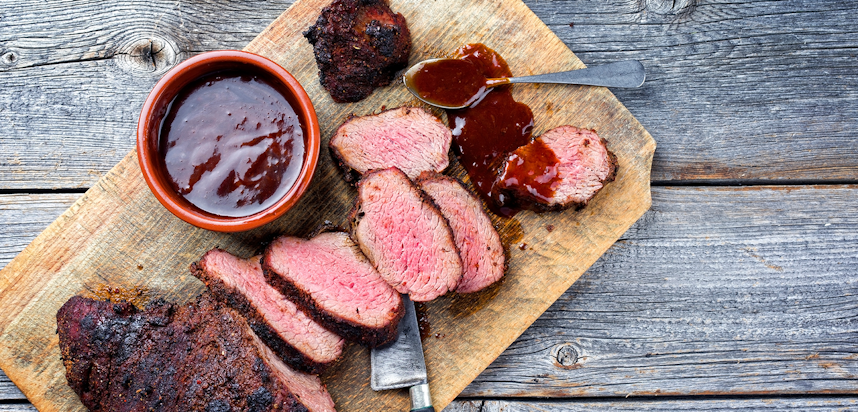
What is barbecue sauce?
Barbecue sauce is a condiment used both alone and as an ingredient in barbecue cooking. It is largely associated with South states of Northern America, where it is the most popular and common condiment.
A type of barbecue sauce from South Carolina, using mustard as the base ingredient, can be traced back to the 1700s and German settlers. Despite this, most early barbecue sauce recipes included only vinegar salt and pepper, with things like sugar and ketchup added as the product evolved. Today different geographical regions all have their own take on barbecue sauce, with varying ingredients, among them vinegar, tomato paste or puree, mayonnaise, onion powder, garlic granules, mustard, black pepper, liquid smoke, molasses, sugar, paprika, and Worcestershire sauce.
What is barbecue sauce used for?
Predictably, barbecue sauce is mostly eaten with barbecued foods such as ribs, burgers and sausages. It might also be used in the following ways:
- In refried beans
- As a sauce for pulled pork
- To glaze ham
- As a dipping sauce for fries and fast food
- As a pizza sauce
- In salad dressing
Is barbecue sauce vegan?
Most barbecue sauce is vegan, and not made with animal-derived ingredients, with the exception of those made with Worcestershire sauce - which contains Fish.
Allergen alert
Depending on the individual recipe, barbecue sauce might contain Mustard, Sulphur Dioxide, Cereals containing Gluten and Fish (only if Worcestershire sauce is an ingredient).
Soy sauce
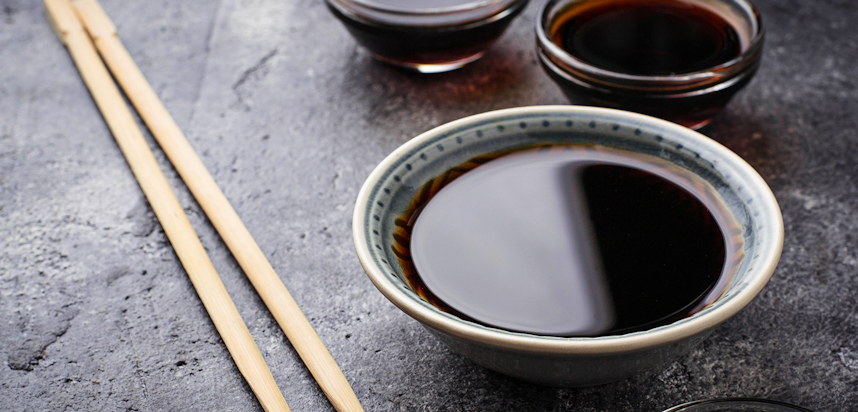
What is soy sauce?
Soy sauce is a thin, liquid condiment of Chinese origin and a strong umami taste. It is a popular part of Chinese and Japanese cuisine, and traditionally made from soybeans, wheat and water. The soybeans come in a fermented paste of soybeans, roasted grain, brine, and Aspergillus oryzae.
The sauce is thought to go back as far as the Western Han dynasty (206 BC – 220 AD).
Commercially manufactured soy sauce will likely contain ingredients such as water, sugar, salt, flavourings and colourings in addition to soy beans and wheat.
What is soy sauce used for?
Soy sauce is eaten with many Asian dishes, and also several Western ones too.
These include:
- Rice
- Noodles
- Sushi
- Sashimi
- Marinated meat
- Glazed fish or meat
- Spring rolls
- Dumplings
- Stir fries
Is soy sauce vegan?
Yes, soy sauce is entirely plant-based and vegan-friendly.
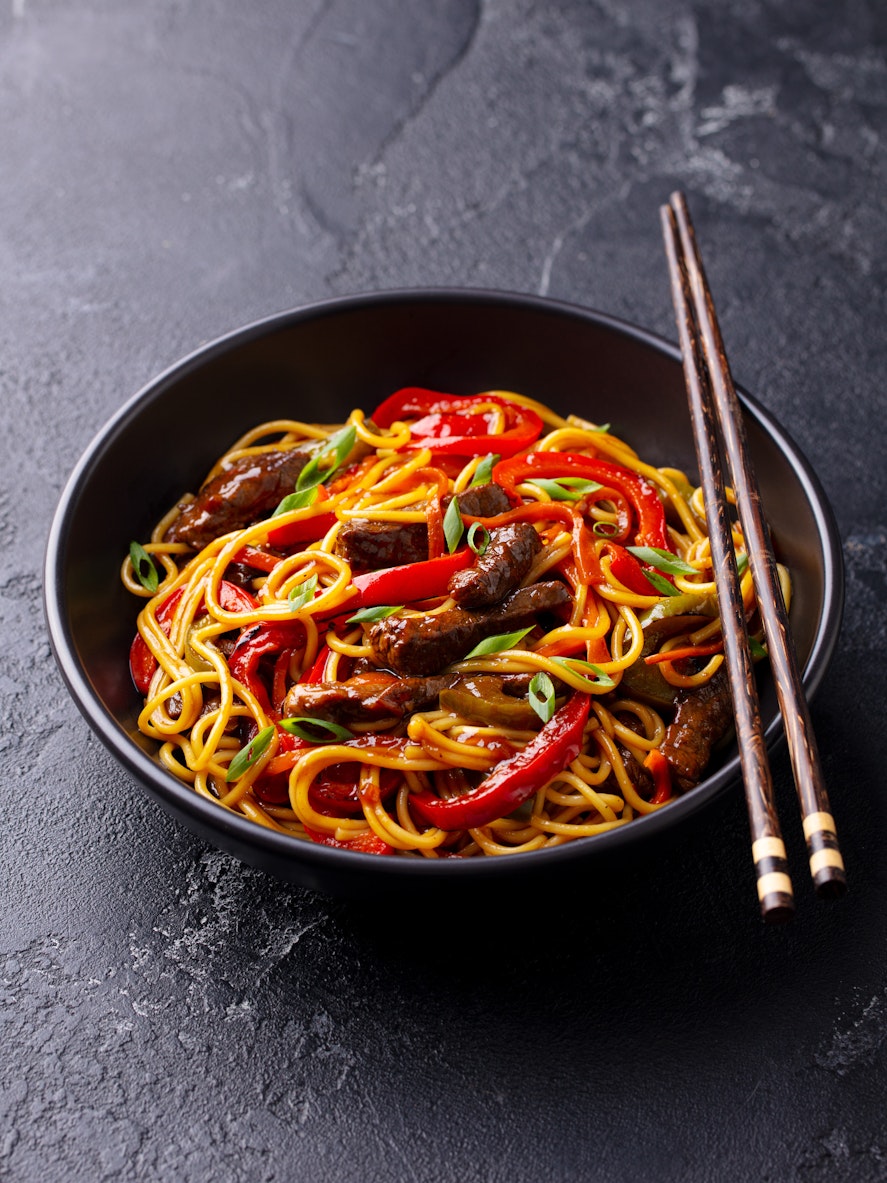
Allergen alert
Soy sauce is made with Soya and Wheat, a Cereal containing Gluten. Both of these are among the 14 major food allergens.
Soy sauce and wasabi are both popular condiments in Japanese cuisine. Some people mix the 2 together to create a concoction known as “wasabi joyu”, but it is actually bad etiquette to eat them simultaneously.
